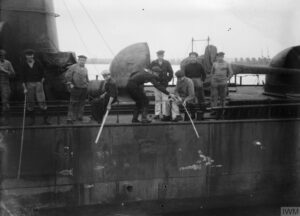
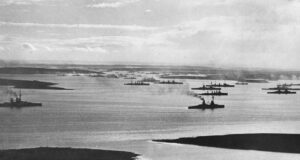 After the November 11, 1918 German surrender in World War I, the German fleet was interned at Scapa Flow under the terms of the Armistice of 11 November, while negotiations took place over its fate. There was talk of the fleet being divided between the Allied nations, and there were those who really wanted that, but this brought the fear that the British would seize the ships, and the Germans worried that if the German government at the time might rejected the Treaty of Versailles and resumed the war effort, the newly confiscated German ships could be used against Germany. Amid all the speculation, Admiral Ludwig von Reuter decided to scuttle the fleet.
After the November 11, 1918 German surrender in World War I, the German fleet was interned at Scapa Flow under the terms of the Armistice of 11 November, while negotiations took place over its fate. There was talk of the fleet being divided between the Allied nations, and there were those who really wanted that, but this brought the fear that the British would seize the ships, and the Germans worried that if the German government at the time might rejected the Treaty of Versailles and resumed the war effort, the newly confiscated German ships could be used against Germany. Amid all the speculation, Admiral Ludwig von Reuter decided to scuttle the fleet.
Scapa Flow was a naval base in the Orkney Islands in Scotland. When the German ships arrived, they had full crews and in all, there were more than 20,000 German sailors aboard, the number of sailors was reduced in the ensuing months. When the full fleet was at Scapa Flow, there were 74 ships there during negotiations between the Allies and Germany over a peace treaty that would become Versailles. The discussion was about what to do with the ships, since they didn’t really want Germany to have a full fleet ready, should they decide to wage war again. The French and Italians wanted a portion of the fleet, but the British wanted them destroyed. They were concerned about their own naval superiority, should the ships be distributed among the other Allied nations.
The Germans didn’t want their ships in the hand of their enemies, so Admiral Ludwig von Reuter began to prepare for the scuttling in May 1919, after hearing about the potential terms of the Versailles Treaty. Shortly before the treaty was signed on June 21, Reuter sent the signal to his men. The men began opening flood valves, smashing water pipes, and opening sewage tanks. As the scuttle was taking place, nine German crew members who abandoned ship and attempted to come ashore were shot by British forces. As the ships were being scuttled, the intervening British guard ships were able to beach some of the ships. In all, 52 of the 74 ships were sunk. While he wouldn’t say so out loud, British Admiral Wemyss was delighted that the ships were 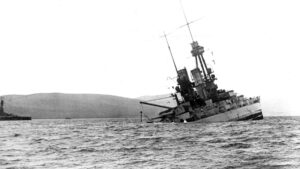
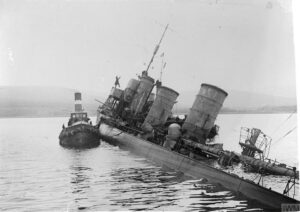 sunk, because that meant they wouldn’t be distributed to the French and Italians navies. Since the scuttling, many ships have been refloated and salvaged in the years since. Nevertheless, some remain in the seas at Scapa Flow. Those that remain are popular diving sites and a source of low-background steel.
sunk, because that meant they wouldn’t be distributed to the French and Italians navies. Since the scuttling, many ships have been refloated and salvaged in the years since. Nevertheless, some remain in the seas at Scapa Flow. Those that remain are popular diving sites and a source of low-background steel.

 In June of 1942, Flight Sergeant Dennis Copping, a 24-year-old British pilot, who was part of the 260 Squadron of the RAF Volunteer Reserves was tasked with flying P-40 Kittyhawk (serial code ET574), on a ferry flight to a neighboring British airbase to have the undercarriage repaired. The upcoming Summer Offensive that year, was to include the P-40s. Copping took off on June 28 and headed West. He was never seen again, even with extensive searches being undertaken. Both the aircraft and its pilot were reported missing. After a time, the search was called off, because they couldn’t find anything.
In June of 1942, Flight Sergeant Dennis Copping, a 24-year-old British pilot, who was part of the 260 Squadron of the RAF Volunteer Reserves was tasked with flying P-40 Kittyhawk (serial code ET574), on a ferry flight to a neighboring British airbase to have the undercarriage repaired. The upcoming Summer Offensive that year, was to include the P-40s. Copping took off on June 28 and headed West. He was never seen again, even with extensive searches being undertaken. Both the aircraft and its pilot were reported missing. After a time, the search was called off, because they couldn’t find anything.
The lost flight stayed a mystery for almost 70 years. Then, in April 2012, workers of a Polish Oil company discovered the remarkably well-preserved remains of a P-40. It’s quite likely that they not only had no idea how it could have come to be there, nor when. Nevertheless, the desert’s extremely dry conditions had basically ‘mummified” the P-40, as it only showed minimal rust and decay.
The wings of the P-40 were half-buried under the sand, but they were still in very good condition, with the exception of the fact that the fabric-covered control surfaces had rotten away. Even the cockpit was still somewhat preserved, and the aircraft still had live ammunition loaded in the magazines of its six machine guns.
When the authorities were called in, they were easily able to link the downed P-40 Kittyhawk to Dennis  Copping, because of its relatively good condition. They finally knew what had happened to Flight Sergeant Dennis Copping and his Kittyhawk exactly 69 years, 9 months, and 14 days later. The only thing missing was the pilot. It was then assumed that Copping had survived the crash, but where was he? The only thing they could assume was that he must have tried to walk out. The problem is that Copping was lost and alone in the middle of the largest desert on Earth. They began the search again, but this time with the plane as a starting point.
Copping, because of its relatively good condition. They finally knew what had happened to Flight Sergeant Dennis Copping and his Kittyhawk exactly 69 years, 9 months, and 14 days later. The only thing missing was the pilot. It was then assumed that Copping had survived the crash, but where was he? The only thing they could assume was that he must have tried to walk out. The problem is that Copping was lost and alone in the middle of the largest desert on Earth. They began the search again, but this time with the plane as a starting point.
They found a small makeshift camp built next to the aircraft. Near it was the plane’s battery and radio. This meant that Copping probably attempted to broadcast for help. Unfortunately, the radio, or at least the internal workings of it had been destroyed by the crash landing. Finally, unable to call for help, Copping knew he would have to leave the plane and go for help. The teams continued their search, and a group of Italian historians uncovered a number of human bones five kilometers from the crash site. However, it was decided that those bones probably “did not belong” to Copping as they were “too old” to be his. Interestingly, the bones were never tested for any DNA. The historians were also able to find a section of the parachute, a keyfob, and a buckle stamped ‘1939,’ which were things Copping might have had with him at the time of his death.
Because of the desert’s dry conditions, the ET574 Kittyhawk was able to be fully restored. Of course, given the 
 years and the fact that it was a crash, the restoration is far from perfect. and it sports a historically inaccurate camouflage scheme. Maybe someday, it will be restored to a historically accurate condition. Nevertheless, it is the last surviving example of a Desert Air Force P-40 Kittyhawk in existence. The mystery was finally solved.
years and the fact that it was a crash, the restoration is far from perfect. and it sports a historically inaccurate camouflage scheme. Maybe someday, it will be restored to a historically accurate condition. Nevertheless, it is the last surviving example of a Desert Air Force P-40 Kittyhawk in existence. The mystery was finally solved.
 The Civil War was fought for a number of reasons, but the biggest reason was the slave issue. During the war between the North and South, came President Lincoln’s Emancipation Proclamation on January 1, 1863, and the freedom of the slaves…well, most of them, anyway. Of course, things like this come in stages. The Proclamation had the effect of “changing the legal status of more than 3.5 million enslaved African Americans in the secessionist Confederate states from enslaved to free. As soon as slaves escaped the control of their enslavers, either by fleeing to Union lines or through the advance of federal troops, they were permanently free. In addition, the Proclamation allowed for former slaves to ‘be received into the armed service of the
The Civil War was fought for a number of reasons, but the biggest reason was the slave issue. During the war between the North and South, came President Lincoln’s Emancipation Proclamation on January 1, 1863, and the freedom of the slaves…well, most of them, anyway. Of course, things like this come in stages. The Proclamation had the effect of “changing the legal status of more than 3.5 million enslaved African Americans in the secessionist Confederate states from enslaved to free. As soon as slaves escaped the control of their enslavers, either by fleeing to Union lines or through the advance of federal troops, they were permanently free. In addition, the Proclamation allowed for former slaves to ‘be received into the armed service of the 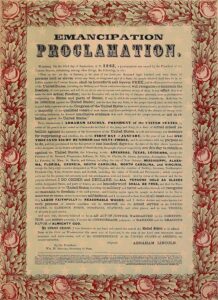 United States.’ The Emancipation Proclamation played a significant part in the end of slavery in the United States.”
United States.’ The Emancipation Proclamation played a significant part in the end of slavery in the United States.”
This all seemed simple enough, if the slave could escape, but they had to know about the Emancipation Proclamation, and the slaveowners in Texas decided not to tell them that they could be free. The Proclamation had the effect of changing the legal status of more than 3.5 million enslaved African Americans in the secessionist Confederate states from enslaved to free. As soon as slaves escaped the control of their enslavers, either by fleeing to Union lines or through the advance of federal troops, they were permanently free. In addition, the Proclamation allowed for former slaves to “be received into the armed service of the United States.” The people of Texas kept their slaves in the dark about everything, including the end of the Civil War Major General Gordon Granger, who had been tasked with enforcing the Emancipation Proclamation. Granger arrived in Galveston until June 19, 1865, where he formally announced that the slaves were free according to  General Order Number 3. It was the first time many of them had heard this good news. Texans began celebrating June 19th as Juneteenth since that time. It became a state holiday in 1979.
General Order Number 3. It was the first time many of them had heard this good news. Texans began celebrating June 19th as Juneteenth since that time. It became a state holiday in 1979.
On April 8, 1864, by the necessary two-thirds vote, the Senate passed the 13th Amendment. The House of Representatives passed it on January 31, 1865, and the required three-fourths of the states ratified it on December 6, 1865. The amendment made slavery and involuntary servitude unconstitutional, “except as a punishment for a crime.”

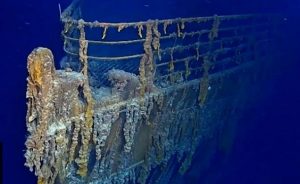 When RMS Titanic sank to the ocean floor after hitting an iceberg on April 15, 1912, it immediately became a “media sensation” for lack of a better term. Everyone wanted to know more about the ship. They wanted first to find it, and when it was finally located, everyone wanted to see and hear more about it. Once submarines were created to be able to go to that depth, the wreck was researched and view the world over. Still, people couldn’t “visit” the ship. It became an obsession similar I suppose to a trip to outer space. Still, you knew that at some point, someone would pave the way for excursions to the site of the Titanic wreck and with that would come the eventual possibility for anyone with enough money to purchase a ticket to make the journey for the sake of being able to actually say they “had been there.”
When RMS Titanic sank to the ocean floor after hitting an iceberg on April 15, 1912, it immediately became a “media sensation” for lack of a better term. Everyone wanted to know more about the ship. They wanted first to find it, and when it was finally located, everyone wanted to see and hear more about it. Once submarines were created to be able to go to that depth, the wreck was researched and view the world over. Still, people couldn’t “visit” the ship. It became an obsession similar I suppose to a trip to outer space. Still, you knew that at some point, someone would pave the way for excursions to the site of the Titanic wreck and with that would come the eventual possibility for anyone with enough money to purchase a ticket to make the journey for the sake of being able to actually say they “had been there.”
When Titan was created, that dream became a reality…for a time. Titan was a submersible operated by the private American tourism and expeditions company OceanGate. The company was founded in 2009 by Stockton Rush and Guillermo Söhnlein. Beginning in 2010, OceanGate took paying customers in leased commercial submersibles off the coast of California, in the Gulf of Mexico, and in the Atlantic Ocean. OceanGate was in Everett, Washington. The trips were profitable, but Rush couldn’t get past the thought that visiting shipwreck sites would be a great way to generate media attention. OceanGate had gone to a few other shipwrecks, including its 2016 dive to the wreck of Andrea Doria aboard their other submersible Cyclops 1. Then in 2019, Rush told Smithsonian magazine: “There’s only one wreck that everyone knows … If you ask people to name something underwater, it’s going to be sharks, whales, Titanic.” And in the end, all three can prove deadly.
The unfortunate reality was that while Titan looked very cool and would likely be just the media draw that Rush had hoped for, the materials used in its construction were not what would be needed to make it a safe vehicle at the depth of the Titanic. Rush didn’t see that the vehicle was dangerous, even though several people told him it was unsafe. Some people who had planned to go even cancelled before that fateful trip, but unfortunately not all od them. In the end, five people, including Rush made the trip to see Titanic for themselves. Also aboard the submersible were Paul-Henri Nargeolet, a French deep-sea explorer and Titanic expert, Hamish Harding, a British businessman; Shahzada Dawood, a Pakistani-British businessman and Dawood’s son, Suleman. One hour and 45 minutes into the dive, communication between Titan and its mother ship, MV Polar Prince, was lost. Everyone knew what that meant, but they couldn’t give up hope. When Titan 
 failed to resurface at the scheduled time later that day the authorities were notified. Four days later, a remotely operated underwater vehicle (ROV) discovered a debris field containing parts of Titan, about 1,600 feet from the bow of the Titanic. Of course, all onboard were crushed to death instantly. They would not have felt a thing.
failed to resurface at the scheduled time later that day the authorities were notified. Four days later, a remotely operated underwater vehicle (ROV) discovered a debris field containing parts of Titan, about 1,600 feet from the bow of the Titanic. Of course, all onboard were crushed to death instantly. They would not have felt a thing.
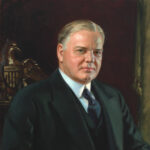
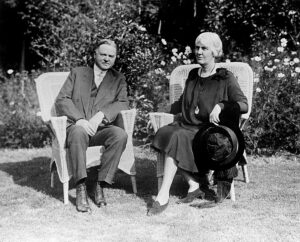 For nearly a month beginning June 17, 1900, the man who would become President Herbert Hoover and his wife, Lou were caught up in what was to become known as the Boxer Rebellion in China. During the Boxer Rebellion, the community of foreigners the Hoovers lived in, in the city of Tianjin, was besieged and under attack. You might wonder how a future president could be caught up in such a situation, but remember, he wasn’t president yet. He was a citizen. After they were married in Monterey, California, on February 10, 1899, Herbert and Lou Hoover left on a honeymoon cruise to China. Following their honeymoon, Hoover started his new job as a mining consultant to the Chinese emperor with the consulting group Bewick, Moreing and Company.
For nearly a month beginning June 17, 1900, the man who would become President Herbert Hoover and his wife, Lou were caught up in what was to become known as the Boxer Rebellion in China. During the Boxer Rebellion, the community of foreigners the Hoovers lived in, in the city of Tianjin, was besieged and under attack. You might wonder how a future president could be caught up in such a situation, but remember, he wasn’t president yet. He was a citizen. After they were married in Monterey, California, on February 10, 1899, Herbert and Lou Hoover left on a honeymoon cruise to China. Following their honeymoon, Hoover started his new job as a mining consultant to the Chinese emperor with the consulting group Bewick, Moreing and Company.
In 1900, a Chinese secret organization called the Society of the Righteous and Harmonious Fists led an uprising in northern China against the spread of Western and Japanese influence there. The uprising would become known as the Boxer Rebellion of 1900. The rebels performed calisthenics rituals and martial arts that they believed would give them the ability to withstand bullets and other forms of attack. Westerners referred to these rituals as shadow boxing, leading to the Boxers nickname. They also killed foreigners and Chinese Christians, and they destroyed foreign property.
The Boxers besieged the foreign district of China’s capital city Beijing, which was called Peking then, from June to August. It was at that point that an international force that included American troops ended the uprising. By the terms of the Boxer Protocol, which officially ended the rebellion in 1901, China agreed to pay more than $330 million in reparations. In the end, America returned the money it received from China after the Boxer Rebellion, on the condition it be used to fund the creation of a university in Beijing. Other nations involved later remitted their shares of the Boxer indemnity too.
Western nations and Japan had forced China’s ruling Qing dynasty to accept wide foreign control over the country’s economic affairs by the end of the 19th century. China had resisted the efforts throughout the Opium 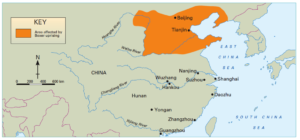 Wars of 1839-1842 and 1856-1860, by means of popular rebellions and the Sino-Japanese War, but without a modernized military, China had suffered millions of casualties.
Wars of 1839-1842 and 1856-1860, by means of popular rebellions and the Sino-Japanese War, but without a modernized military, China had suffered millions of casualties.
John Hay, the US Secretary of State from 1898 to 1905, began to implement an “Open Door Policy” to push for American and European influence over the Chinese trade and economic partnerships. The Open Door Policy called for a system of equal trade and investment and to guarantee the territorial integrity of Qing China. The policy was met with indifference or resistance by other key players, including the Qing Empress Dowager Tzu’u Hzi, but it brought continued Western influence over domestic Chinese affairs, and it set the stage for the rebellion.
The Boxers came from various parts of society, but many were peasants, particularly from Shandong province, which had been struck by natural disasters such as famine and flooding. These things made them particularly volatile. In the 1890s, China had given territorial and commercial concessions in this area to several European nations, and the Boxers blamed their poor standard of living on foreigners who were colonizing their country.
The siege stretched into weeks, and the diplomats (including the Hoovers), their families, and guards suffered through hunger and degrading conditions as they fought to keep the Boxers at bay, while the Western powers and Japan organized a multinational force to crush the rebellion. It is thought that several hundred foreigners and several thousand Chinese Christians were killed during this time. On August 14, after fighting its way through northern China, the rescue began, when an international force of approximately 20,000 troops from eight nations, including Austria-Hungary, France, Germany, Italy, Japan, Russia, the United Kingdom and the United States arrived to take Beijing. The Boxer Rebellion formally ended with the signing of the Boxer Protocol on September 7, 1901. “By terms of the agreement, forts protecting Beijing were to be destroyed, Boxer and Chinese government officials involved in the uprising were to be punished, foreign legations were permitted to 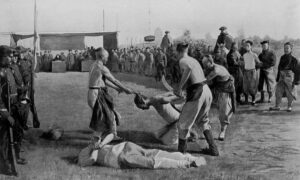
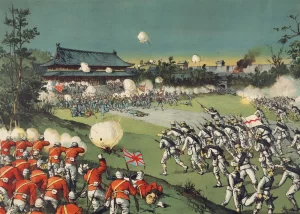 station troops in Beijing for their defense, China was prohibited from importing arms for two years and it agreed to pay more than $330 million in reparations to the foreign nations involved.” The Qing dynasty, which was established in 1644, was weakened by the Boxer Rebellion. Following an uprising in 1911, the dynasty came to an end and China became a republic in 1912.
station troops in Beijing for their defense, China was prohibited from importing arms for two years and it agreed to pay more than $330 million in reparations to the foreign nations involved.” The Qing dynasty, which was established in 1644, was weakened by the Boxer Rebellion. Following an uprising in 1911, the dynasty came to an end and China became a republic in 1912.
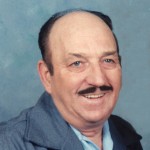
 We all have one, and some of us were blessed with two, either a father-in-law, or a stepdad, or even a mentor for those who never knew their own dad. I was one of those who were blessed with a wonderful dad and a wonderful father-in-law, and I have always felt incredibly blessed to have had both. My dad, Allen Spencer was such a gentle and loving dad. He really was the perfect “Girl Dad” and his girls were his princesses. We grew up knowing that we were among the most blessed people on Earth. I met my father-in-law, Walt Schulenberg in 1974, and he immediately welcomed me into their home. That welcome lasted until the day he died, and I was so blessed by this man. I love and miss both my dads very much.
We all have one, and some of us were blessed with two, either a father-in-law, or a stepdad, or even a mentor for those who never knew their own dad. I was one of those who were blessed with a wonderful dad and a wonderful father-in-law, and I have always felt incredibly blessed to have had both. My dad, Allen Spencer was such a gentle and loving dad. He really was the perfect “Girl Dad” and his girls were his princesses. We grew up knowing that we were among the most blessed people on Earth. I met my father-in-law, Walt Schulenberg in 1974, and he immediately welcomed me into their home. That welcome lasted until the day he died, and I was so blessed by this man. I love and miss both my dads very much.
My husband, Bob Schulenberg is also a “Girl Dad” and was a huge blessing to our girls. Of course, they usually had him wrapped around their little fingers, but his didn’t seem to mind. They were his little girls, and he loved them more than words could say. When our girls got married, Bob received the sons he never had. The biggest blessings of the husbands of our daughters, Kevin Petersen and Travis Royce, is that they have stood by our 

 girls and their children. They have made them so happy, and that makes us very happy. With the marriages of our girls, we were introduced to the world of boys. My sisters thought it was probably a “culture shock” for us, since we didn’t have sons, and they were likely right. Yes, boys are quite different, but Chris Petersen, Caalab Royce, and Josh Petersen, have blessed our lives in more ways than they know, and we were blessed with one granddaughter, Shai Royce.
girls and their children. They have made them so happy, and that makes us very happy. With the marriages of our girls, we were introduced to the world of boys. My sisters thought it was probably a “culture shock” for us, since we didn’t have sons, and they were likely right. Yes, boys are quite different, but Chris Petersen, Caalab Royce, and Josh Petersen, have blessed our lives in more ways than they know, and we were blessed with one granddaughter, Shai Royce.
Of our grandsons, we now have two who have families of their own. Chris Petersen and his wife, Karen have three children, Cambree, Caysen, and Cyler. Josh Petersen and his wife, Athena have two sons, Justin and Axel, and one child on the way. These young men have been a great blessing to their families, and I can’t tell you how proud of them I am. They work hard and help their wives with the kids, and their kids are all love their daddies so much. Their families couldn’t ask for better husbands and dads. They love their families so much.

 Being a dad is so much more that having kids. Being a dad is about being a provider, mentor, friend, protector, and playmate. After a long day at work, a good dad comes home to spend time with his family, and not to push them away. They may be tired, but their families love them, and they have missed them all day. They want to spend time with them. These guys are good dads, every single one of them, and that is why their families are so blessed. Happy Father’s Day to all the dads in my family, here and in heaven, and all dads everywhere. Have a great day. We, your families love you very much!!
Being a dad is so much more that having kids. Being a dad is about being a provider, mentor, friend, protector, and playmate. After a long day at work, a good dad comes home to spend time with his family, and not to push them away. They may be tired, but their families love them, and they have missed them all day. They want to spend time with them. These guys are good dads, every single one of them, and that is why their families are so blessed. Happy Father’s Day to all the dads in my family, here and in heaven, and all dads everywhere. Have a great day. We, your families love you very much!!

 My grandnephew, James Renville and his wife, Manuela have been having a very good year. Last year, just shortly after James’ birthday, they traveled to Colombia so that James could meet his new extended family for the first time. When he and Manuela were married on July 21, 2021, her family could not travel to attend, because of Covid restrictions. They were sad that they couldn’t come, but they loved James, whom they had spoked to over Skype a number of times, so they were happy they were getting married. James was very excited to meet them, and he loved them instantly. As it turns out, James and his mother-in-law, Consuelo share the same birthday, and Manuela’s sister, Sarah is the day before. (Happy birthday to Consuelo and Sarah too) They were excited that James and Manuela were coming and had made plans to have a big birthday bash for the two of them.
My grandnephew, James Renville and his wife, Manuela have been having a very good year. Last year, just shortly after James’ birthday, they traveled to Colombia so that James could meet his new extended family for the first time. When he and Manuela were married on July 21, 2021, her family could not travel to attend, because of Covid restrictions. They were sad that they couldn’t come, but they loved James, whom they had spoked to over Skype a number of times, so they were happy they were getting married. James was very excited to meet them, and he loved them instantly. As it turns out, James and his mother-in-law, Consuelo share the same birthday, and Manuela’s sister, Sarah is the day before. (Happy birthday to Consuelo and Sarah too) They were excited that James and Manuela were coming and had made plans to have a big birthday bash for the two of them.
James loved spending time with his in-laws, and he said that Consuelo and Manuela’s dad, Edwin took  such good care of them. They were so pleased with James, and the showed him such amazing hospitality. Consuelo is an excellent cook, and she spoiled both them with delicious meals. Cooking is her way of showing great love for her family, so James and Manuela really felt the love.
such good care of them. They were so pleased with James, and the showed him such amazing hospitality. Consuelo is an excellent cook, and she spoiled both them with delicious meals. Cooking is her way of showing great love for her family, so James and Manuela really felt the love.
Manuela loved showing James where she grew up along with other special places in her beautiful home country. They had such a marvelous time, and they are already making plans to go again, as soon as they can get it worked out. James loves to travel, so having extended family in Colombia is very special to him. I’m sure there will be many trips there in the future. Consuelo took a real liking to James, and I know they will be lifelong friends too. James has kind and loving heart, so I am not surprised that she loves him already. James and Manuela took a trip to Marco Island Florida in May and had a great time there too. Taking a break from everyday life to enjoy some fun in the sun together.

 James has been moving into a new phase in his life. He and Manuela are buying their first home, and it is very special to James, because it is the home he grew up in. After she remarried, James’ mom, Toni Chase kept the old place and rented it to her sister, Elizabeth Masterson. Now, Elizabeth wants to buy a place of her own, so James jumped at the chance of owning his childhood home. He is excited about renovating it with Manuela, and making it their own, with their own tastes and touches. James has told his mom several times this year, that he is incredibly blessed!! He has a great job!! A great wife!! A great family!! And a great life!! Today is James’ birthday. Happy birthday James!! Have a great day!! We love you!!
James has been moving into a new phase in his life. He and Manuela are buying their first home, and it is very special to James, because it is the home he grew up in. After she remarried, James’ mom, Toni Chase kept the old place and rented it to her sister, Elizabeth Masterson. Now, Elizabeth wants to buy a place of her own, so James jumped at the chance of owning his childhood home. He is excited about renovating it with Manuela, and making it their own, with their own tastes and touches. James has told his mom several times this year, that he is incredibly blessed!! He has a great job!! A great wife!! A great family!! And a great life!! Today is James’ birthday. Happy birthday James!! Have a great day!! We love you!!

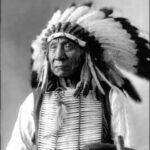 When my grandfather first met Chief Red Cloud, it was an eye-opening experience for sure. I’m not exactly sure how old Grandpa was at the time, but since Red Cloud died when my grandfather was 16 years old, I have a timeframe to start with. Red Cloud was born near the forks of the Platte River in 1820 (exact date is unknown). He was one of a family of nine children whose father, an able and respected warrior. Red Cloud lived in an exemplary life. He was faithful to one wife all his days and was a devoted father to his children. He wanted great things for his only son, known as Jack Red Cloud. He wanted his sone to be a great warrior too and started him on the warpath at the age of fifteen. Of course, at this point, Red Cloud didn’t realize that the days of Indian warfare were very close to an end. Among the chiefs of his era, Red Cloud was known as a quiet man, simple and direct in speech, courageous in action, an ardent lover of his country. He possessed all the manly qualities characteristic of the American Indian in his best days. Red Cloud lived a long life and died on December 10, 1909, of natural causes.
When my grandfather first met Chief Red Cloud, it was an eye-opening experience for sure. I’m not exactly sure how old Grandpa was at the time, but since Red Cloud died when my grandfather was 16 years old, I have a timeframe to start with. Red Cloud was born near the forks of the Platte River in 1820 (exact date is unknown). He was one of a family of nine children whose father, an able and respected warrior. Red Cloud lived in an exemplary life. He was faithful to one wife all his days and was a devoted father to his children. He wanted great things for his only son, known as Jack Red Cloud. He wanted his sone to be a great warrior too and started him on the warpath at the age of fifteen. Of course, at this point, Red Cloud didn’t realize that the days of Indian warfare were very close to an end. Among the chiefs of his era, Red Cloud was known as a quiet man, simple and direct in speech, courageous in action, an ardent lover of his country. He possessed all the manly qualities characteristic of the American Indian in his best days. Red Cloud lived a long life and died on December 10, 1909, of natural causes.
Red Cloud, like most chiefs was a warrior in his day. He was famous for Red Cloud’s War that took place between 1866 and 1868. Nevertheless, Red Cloud was a wise man, and he saw that if his people were going to survive, they would have to make peace with and learn to coexist with the White Man. He was also a man who wanted peace. In 1887, he opposed the Dawes Act, which broke up communal tribal holdings and allocated 160-acre plots of land for subsistence farming to heads of families on tribal rolls. Then, the US declared additional communal tribal lands as excess and sold them to immigrant settlers. In 1889, Red Cloud opposed a treaty to sell more of the Lakota land. Red Cloud and Sitting Bull steadfastly opposed the 1889 treaty, but government agents obtained the necessary signatures for approval only through cheating, such as using the signatures of children. Red Cloud negotiated strongly with Indian Agents such as Dr Valentine McGillycuddy, who was an honest man and highly respected by the Lakota. For the rest of his life, Red Cloud advocated for 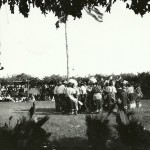
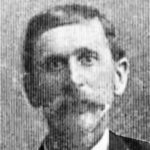
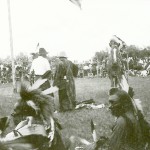 Native American rights to the Black Hills. During this time, June 15, 1893, to be exact, my grandfather was born in Springfield, South Dakota. The advocating Red Cloud did in those years was less violent, and more intellectual, although not any more fruitful than any other advocating he did. There were very few White Men he trusted…among them, my great grandfather, Cornelius Byer.
Native American rights to the Black Hills. During this time, June 15, 1893, to be exact, my grandfather was born in Springfield, South Dakota. The advocating Red Cloud did in those years was less violent, and more intellectual, although not any more fruitful than any other advocating he did. There were very few White Men he trusted…among them, my great grandfather, Cornelius Byer.
My great grandfather was invited to the Pow Wows and invited to sit in on their tribal meetings. He was also so respected by the Native Americans, that when he was dying, they all came to see him…bringing their wives and children to tell him goodbye. When he passed away, they followed him as far as they could toward his final resting place in Iowa. That said, between the year of my grandfather’s birth and the death of Red Cloud, I believe when my grandfather was about 12 years old, my great grandfather took my grandfather to visit Red Cloud. The Native American culture was quite different than the White Man’s. When Great Grandpa and Grandpa went into Red Cloud’s teepee, he was sitting there under a blanket. Red Cloud stood up to get a peace pipe to offer to Great Grandpa and the other men in the room. That was all fairly normal, even for my grandfather, but the fact that Red Cloud was naked was not something my grandfather was used to. In fact, my Aunt Sandy tells me that she doesn’t remember ever seeing her dad shirtless. He always wore at least a t-shirt, whether indoors or outdoors, in Summer or Winter. I’m sure Grandpa’s eyes were as big as saucers, until his dad nudged him, basically telling him not to stare. Grandpa sat quietly while the men talked, and then the peace pipe was lit. As it was handed around the circle, Red Cloud handed it to my grandfather. My grandfather looked at his dad, and Great Grandpa nodded his head. With that one motion, my grandfather was allowed to 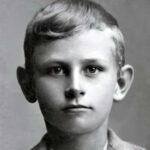
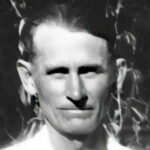 take his first puff of a peace pipe. I don’t know if Grandpa ever met with Red Cloud again, although I assume he did, and I don’t know if he ever smoked a peace pipe again either, but he did that day, and it was a moment in his life that he never forgot. It wouldn’t surprise me to find out that he smoked the peace pipe again either. It was a story he told to his children many times through the years. It was a sign of respect from the Lakota toward my grandpa, and from my grandpa toward them. Today is the 131st anniversary of my grandfather’s birth. Happy birthday in Heaven, Grandpa Byer. We love and miss you very much.
take his first puff of a peace pipe. I don’t know if Grandpa ever met with Red Cloud again, although I assume he did, and I don’t know if he ever smoked a peace pipe again either, but he did that day, and it was a moment in his life that he never forgot. It wouldn’t surprise me to find out that he smoked the peace pipe again either. It was a story he told to his children many times through the years. It was a sign of respect from the Lakota toward my grandpa, and from my grandpa toward them. Today is the 131st anniversary of my grandfather’s birth. Happy birthday in Heaven, Grandpa Byer. We love and miss you very much.

 My great grandnephew, Max Herr is a very busy boy these days. He comes from a pretty athletic family, and so it stands to reason that he would also be into sports. Right now, he is in t-ball, basketball, and swimming, and if that isn’t enough, he also “coaches” his mommy, Katy Herr in her workouts. Not bad for a little guy of just four years today. Max loves to go golfing with his daddy, Dylan Herr too.
My great grandnephew, Max Herr is a very busy boy these days. He comes from a pretty athletic family, and so it stands to reason that he would also be into sports. Right now, he is in t-ball, basketball, and swimming, and if that isn’t enough, he also “coaches” his mommy, Katy Herr in her workouts. Not bad for a little guy of just four years today. Max loves to go golfing with his daddy, Dylan Herr too.
Max loves all things boy, so things like sports, superheroes, monster trucks, and any other “boy stuff” you can think of. He loves his mommy and daddy very much, but right now, he is pretty much a “Mama’s Boy,” for a little longer. Boys tend to end up being “Daddy’s Boys” pretty early on. Nevertheless, his 
 Mommy is enjoying it while she can. Katy tells me, “I’m loving every second of it, he is truly my best friend.” Max has the kindest heart and is always making sure everyone is okay. It’s a rare trait in a little boy, to be the one to make sure that everyone around him has what they need to make them happy. Still, that is what Max is all about. He is also HILARIOUS and loves to make people laugh. That is something that is written all over his face every time he smiles. You can tell that he just seems to have an internal joy…such a cool thing. He is one of those kids whose face lights up when he smiles. His whole face smiles when he does, and you can totally tell that he is one happy kid.
Mommy is enjoying it while she can. Katy tells me, “I’m loving every second of it, he is truly my best friend.” Max has the kindest heart and is always making sure everyone is okay. It’s a rare trait in a little boy, to be the one to make sure that everyone around him has what they need to make them happy. Still, that is what Max is all about. He is also HILARIOUS and loves to make people laugh. That is something that is written all over his face every time he smiles. You can tell that he just seems to have an internal joy…such a cool thing. He is one of those kids whose face lights up when he smiles. His whole face smiles when he does, and you can totally tell that he is one happy kid.


When it comes to other kids, Max isn’t around many, but his cousins, Reece and Asa Balcerzak are his best friends (in the world of kids, anyway). He loves hanging out with them. When he goes to school, of course, all that will change. If I guess right, I would say Max will be the “life of the party” and the kid will lots of friends, when he is in school. He is really quite a social guy. I most often run into Max when he and his mom are out shopping. Walmart seems to be the meeting place of many. He always has a smile on his face, and that warms my heart. Max is just a great kid. Today is Max’s 4th birthday. I can’t believe he is four already. Happy 4th birthday Max!! Have a great day!! We love you!!

 My nephew, Garrett Stevens is a welding inspector working for EMIT. Last year, Garrett went to Denver for a three-week school to learn to be a welding inspector. After the school was done, he had to pass 3 or 4 tests before he was given the certification. This process was very difficult, and the person who was sent before Garrett was not able to pass the course, so we are all very proud the Garret was able to pass, and he loves the new job and his new responsibilities.
My nephew, Garrett Stevens is a welding inspector working for EMIT. Last year, Garrett went to Denver for a three-week school to learn to be a welding inspector. After the school was done, he had to pass 3 or 4 tests before he was given the certification. This process was very difficult, and the person who was sent before Garrett was not able to pass the course, so we are all very proud the Garret was able to pass, and he loves the new job and his new responsibilities.
Garrett and his wife, Kayla welcomed their second daughter, Maya just under two years ago, and since that time, they have begun to feel like the walls are closing in on them, so the time has come to sell their home. They have been busy getting a few things renovated and updated so they will get a better price for the house. When I say “they” I include the girls, or at least their daughter Elliott, who is almost six years 
 old. Garrett is a very hands-on dad, and his girls love him to the moon and back. Elliott has been helping with the painting of the kitchen. This isn’t the first painting project Garrett and Elliott have tackled. They painted her playhouse and really had a good time doing that. Elliott is a big helper. She also helped with planting flowers in the front yard. She really like that she is helping her parents get ready to put their house on the market so they can find a bigger house. At two years old, Maya is limited on what she can do, but she wants to be a part of things too, so they give her little projects as well. Garrett and
old. Garrett is a very hands-on dad, and his girls love him to the moon and back. Elliott has been helping with the painting of the kitchen. This isn’t the first painting project Garrett and Elliott have tackled. They painted her playhouse and really had a good time doing that. Elliott is a big helper. She also helped with planting flowers in the front yard. She really like that she is helping her parents get ready to put their house on the market so they can find a bigger house. At two years old, Maya is limited on what she can do, but she wants to be a part of things too, so they give her little projects as well. Garrett and 
 Kayla are really good parents, and time with their girls, even if it’s working to get the house ready to sell, is very important time for them.
Kayla are really good parents, and time with their girls, even if it’s working to get the house ready to sell, is very important time for them.
Garrett and Kayla bought a camper this year, and they are planning some fun camping trips. They have made plans to go up to the mountains, the Tongue River Reservoir in Montana, and to Pathfinder Reservoir with his family for the traditional Steven’s Family Summer Camp Out. They really enjoy camping, and spending time with the family. The new camper will give them plenty of room for their family to enjoy the great outdoors. Today is Garret’s birthday. Happy birthday Garrett!! Have a great day!! We love you!!

